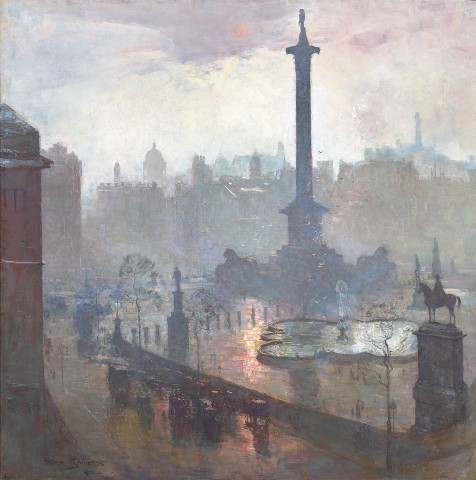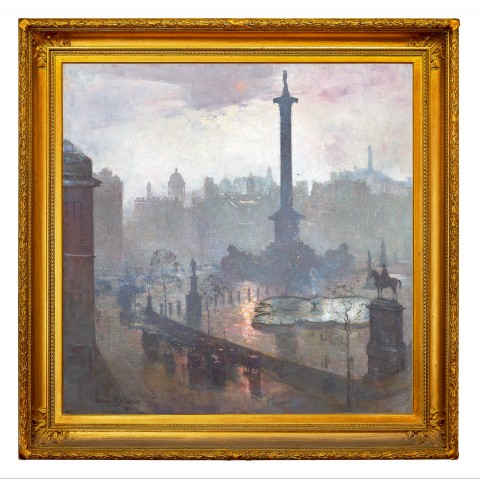THE CENTRE OF THE EMPIRE, 1902
ARTHUR STREETON
oil on canvas
122.5 x 122.5 cm
signed and dated lower left: ArthuR STREETON / 1902
Sir Walter Baldwin Spencer, Melbourne, by 1907
The Baldwin Spencer Collection of Australian Pictures and Works of Art, Fine Art Society, Melbourne, 19 May 1919, lot 30
Acquired from the above by Mr A.T. Creswick, Melbourne, until 1939
Thence by descent
Sir Alexander Reid Creswick, Melbourne, until 1982
Thence by descent
Private collection, Sydney
Salon de la Société des Artistes Français, Grand Palais, Paris, 1 May 1902, cat. 1527 (as ‘Gelée du matin, Londres’)
Arthur Streeton, Ryder Gallery, London, 2 May 1903, cat. 22 (as ‘Trafalgar Square’)
An Exhibition of Pictures by Arthur Streeton Prior to his Return to Europe, Upper Hibernian Hall, Melbourne, 20 April 1907, cat. 67 (illus., as ‘The Centre of the Empire’)
Sir W. Baldwin Spencer’s Collection, National Art Gallery of New South Wales, Sydney, 1 December 1916, cat. 6 (label attached verso)
Loan Exhibition, Collection of Paintings and Drawings by Australian Artists executed during the last 25 to 30 Years, National Art Gallery of New South Wales, Sydney, April 1918, cat. 13 (illus. p.7 of exhibition catalogue, as ‘Centre of the Empire’)
Arthur Streeton Memorial Exhibition, National Gallery of Victoria, Melbourne, 5 September – 7 October 1944, cat. 68 (label attached verso, as ‘The Heart of the Empire’, lent by Mrs Alexander Creswick)
Arthur Streeton 1867–1943, National Gallery of Victoria, Melbourne, 8 December 1995 – 3 November 1996, cat. 59 (label attached verso, as ‘The Centre of the Empire’, lent by Lady Creswick)
Streeton, Art Gallery of New South Wales, Sydney, 7 November 2020 – 14 February 2021 (as ‘The Centre of the Empire’)
Joel, G., ‘Australian Artists in London: A reminiscence’, Art and Architecture, William Brooks and Co., Sydney, vol. 3, no. 3, May – June 1906, p.101 (as ‘the Trafalgar Square picture’)
The Lone Hand, Sydney, 1 July 1907, vol. 1, no. 3, pp. 309, 310 (illus., as ‘The Centre of the Empire’)
Lindsay, L., ‘Arthur Streeton’s place in Australian Art’, Art in Australia, Angus and Robertson Ltd., Sydney, no. 2, 1917, n.p. (as ‘The Centre of the Empire’)
‘The Loan Exhibition’, Sydney Morning Herald, Sydney, 4 April 1918, p.4
‘Australian Pictures: The Spencer Collection’, The Argus, Melbourne, 3 May 1919, p.9 (as ‘The Centre of the Empire’)
Lloyd Jones, C., Stevens, B., & Smith, U., The Art of Arthur Streeton, Angus and Robertson, Sydney, 1919, pl. 25 (illus.)
‘Art Notes: Mr Arthur Streeton Among the Grampians’, The Age, Melbourne, 2 November 1920, p. 8 (as ‘The Centre of the Empire’)
McDonald, J.S., ‘Australian Artists. No. 6. Arthur Streeton’, The Herald, Melbourne, 12 September 1924, p. 6 (as ‘Centre of the Empire’)
Lindsay, L.,’ Arthur Streeton’, Art in Australia, Third Series, no. 40, Art in Australia Ltd., Sydney, October 1931, p. 10 (as ‘The Centre of Empire’)
Streeton, A., The Arthur Streeton Catalogue, Osboldstone & Co., Melbourne, 1935, cat. 258B (as 'Trafalgar Square' (Mr. A. T. Creswick))
Galbally, A., Arthur Streeton, Lansdowne, Melbourne, 1969, cat. 94
Wray, C., Arthur Streeton: Painter of Light, Jacaranda Wiley, Milton, 1993, pp.97, 100, 102
Eagle, M., The Oil Paintings of Arthur Streeton in the National Gallery of Australia, National Gallery of Australia, Canberra, 1994, p.140 (dated as c.1901)
Smith, G., Arthur Streeton 1867–1943, National Gallery of Victoria, Melbourne, 1995, cat. 59, pp.140–141 (illus.)
Tunnicliffe, W., Streeton, Art Gallery of New South Wales and Thames & Hudson, Sydney, 2020, pp.174 – 75, 183 (illus.), 197, 284 – 285, 336, 371
Frosty Noon, 1901, oil on canvas, 122.5 x 122.5 cm, in the collection of the National Gallery of Victoria, Melbourne
210633 Alice Mills, Portrait of Arthur Streeton.jpg
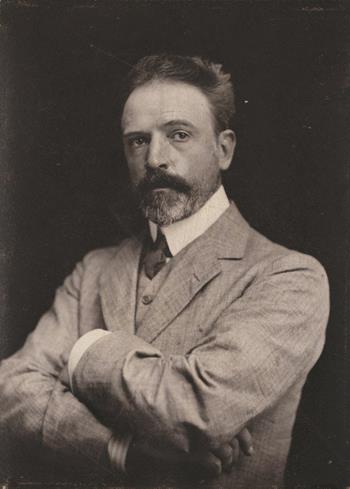
We are grateful to Dr Anne Gray, curator and former Head of Australian Art at the National Gallery of Australia, Canberra, for her permission to reproduce the following excerpt from her essay featured in the catalogue accompanying the recent Streeton retrospective at the Art Gallery of New South Wales, Sydney, 7 November 2020 – 14 February 2021.
‘London & England what a mighty thing it all is ... London seems even too large & almost beyond the management of the capable men now directing it - the rate of its growth increases each day - its wealth stupendous.’1
Arthur Streeton wrote this in London in January 1901. Queen Victoria was ill and dying, and the city, England and the British Commonwealth were on the brink of change. London had become the largest city in Europe,2 and its energy attracted artists, musicians and writers from all over the western world. Streeton arrived in early May 1897, having departed Australia on 27 January.
In England, over more than fifteen years, Streeton began to paint differently. The reasons for this were fourfold.
First, what he saw was not the same: the softer English light and London fog were so different from the bright, sharp light and strong colours of Australia. Also, as he reported to Tom Roberts in June 1898, 'I feel convinced that my work hereafter will contain a larger idea & quality than before - After seeing Constable Turner Titian Watts & all the masters'.3 He saw, too, the works of a wide range of artists of the day. In 1898 he wrote that he preferred the International Society of Sculptors, Painters and Gravers exhibition to the staid presentation of British art at the Royal Academy. The former included works by Charles Conder, James Abbott McNeill Whistler and the Scottish School (the Glasgow Boys), as well as Paul Cézanne, Edgar Degas, Edouard Manet, Claude Monet and the French-based Norwegian artist Frits Thaulow.4
Fourthly, successful artists need a network of advisers and supporters, friends and challengers - even rivals. In Streeton's first years in London, he was adrift without the camaraderie of his mentor Roberts and 'sparring partner, Conder', who lived in England but frequently travelled. His loneliness, poverty and experience of bitter winter led to depression. He was in contact with the photographer H. Walter Barnett, now residing in London,5 but Barnett could not provide relevant advice. It may be that one of Streeton's mistakes was not following an Australian critic's advice to study in Paris.6 He certainly would have met fellow artists, as did Conder (Will Rothenstein and Henri de Toulouse-Lautrec) and John Russell (Vincent van Gogh), and found a circle of friends to provide support and guidance.
210633 Arthur Streeton, Frosty Noon, NGV.jpg
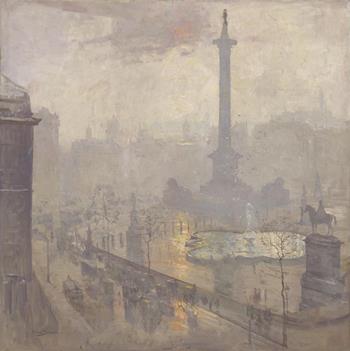
Streeton did meet up with Conder, who was willing to help his old friend and even share his studio with him, but Conder had established himself in France and England, and the balance of the relationship had changed. Following Conder's marriage to Stella Maris Belford in December 1901, Streeton felt more comfortable in his company, and in 1902 spent Christmas with the couple. When Roberts arrived in London in April 1903, Streeton eagerly resumed their friendship. He also encountered a number of former Australian acquaintances, such as the artists E. Phillips Fox and A. Henry Fullwood, and gradually met British artists like Philip Wilson Steer (who in January 1903 supported Streeton's nomination to become a member of the Chelsea Arts Club, where he met further British contemporaries).7
Importantly, by 1899 Streeton had met his future wife, the Canadian violinist Nora Clench. He reported to Roberts that she was 'wise (advises me as you often used to - to spur me into energy & better things)'.8 She was interested in the arts - in poetry and painting - as well as being a highly talented musician, with her own quartet. She had contacts, people who could offer Streeton commissions, such as Walter Russell Rea, who commissioned him in 1905 to depict shipping and dockland scenes at Southampton and Liverpool, and the Mond family, to paint landscapes in Kent in 1913.9
In the summer of 1898, Streeton travelled to Sussex, where he painted his first English landscape, Sussex harvest 1898. To some extent, he adopted a format he had used in Australia, in works such as 'What thou among the leaves hast never known' (also known as A bush idyll), 1896, depicting a scene framed by overarching trees; here, however, he depicted a sunny landscape rather than a poetic moonlit one. By this time, he would have had the opportunity to view John Constable's The cornfield, 1826 (National Gallery, London), which is also a view through trees towards a cornfield, under sunlit clouds. Streeton was dissatisfied with his own painting, writing to Roberts in 1902: ‘The first & only chance I've had yet at English landscape was Sussex soon after my arrival - all too new, & fresh - now - I see more clearly what I can do for myself.’10
It was a 'good enough' first attempt at an English pastoral scene, but he needed more time to assimilate the new landscape, the new light and the ideas of earlier artists. Nonetheless, the painting was exhibited at the Royal Academy in June 1899 and with the Society of Artists in Australia later that year.
NOVL21 Cat proof 7_10_2021 B (2) (002).jpg
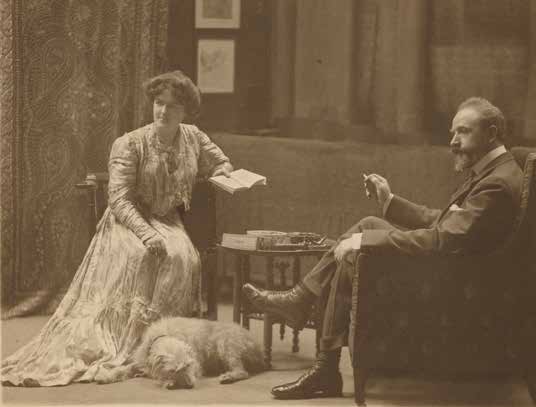
By 1901, Streeton had become accustomed to London's frosty, foggy winter atmosphere. He responded to the muted light in The centre of the Empire (also known as Foggy morning), one of two large square (122.5 x 122.5 cm) images of Trafalgar Square, painted in 1901-02; the other is Frosty noon, 1901 (National Gallery of Victoria). Streeton was not only using a canvas of a similar size and shape to those used by Monet,11 but also, like Monet, painting a similar scene at different times of day. Streeton was also adopting the urban subject often depicted by the French artists. (He had viewed the work of French artists in 1898 in the International Society of Sculptors, Painters and Gravers exhibition and in the Loan collection of pictures by painters of the French school at the Guildhall. He had also spent a week in Paris in 1901. And in May 1902, he travelled to France and Belgium with E. Phillips Fox and Fox may have discussed the ideas of 'broken colour' with Streeton.)12 Streeton regarded his two images of Trafalgar Square as the finest paintings he had produced since arriving in England. He wrote to Roberts in February 1902: ‘Trafalgar Square 4 feet square - Best I've done yet in England - from top of St Martins' Church in Dec. a tough job - drawn in 1 day & painted in 4 days - I'll try it at the R. A. But I get accepted there and never hung - during past week I made a swift copy of it, & it goes tomorrow to the Salon.’13 The 'swift copy' was not so much a copy as a full-scale second version at a different time of day; nothing less would have been appropriate to send to the Société des Artistes Français. Despite Streeton's doubts, one painting was accepted by the Royal Academy and the other by the Société.
In Australia, he had painted atmospheric scenes of the modern city, seen from above, such as The railway station, Redfern, 1893, and Fireman's funeral, George Street, 1894, but this London pair are larger, more ambitious works.14 He showed the beauty of the wintry city under a veiled light, with Trafalgar Square lively and luminous, enveloped in a silvery mist. The reflections gleam on the wet street and in the pond, the line of traffic enlivens the scene, and the ephemeral buildings hover in the background. As a critic wrote in 1909, the image is full of 'tenderness, mystery and harmony of tones'.15
1. Arthur Streeton letter to Tom Roberts, 8 Jan 1901, in Galbally, A. & Gray, A., (eds), Letters from Smike: the letters of Arthur Streeton 1890-1943, Oxford University Press, Melbourne, 1989, p. 85
2. London at that time had a population of around 6,480, 000 - almost double that of Paris.
3. Arthur Streeton letter to Tom Roberts, 28 Jun 1898, in Galbally & Gray, op.cit., p. 78
4. Streeton later owned a work by Frits Thaulow, In Dieppe (private collection). He may have obtained it through Conder, who was a friend of Thaulow.
5. Barnett, with his wife, had travelled with Streeton to Cairo, and had lent Streeton his camera to use in Cairo.
6. Australasian Critic, 1 Jul 1891, p 240. This critic wrote that 'the one thing that is essential to his future reputation is to seek, as soon as possible, the best Parisian instruction'.
7. Streeton was formally elected to membership of the Chelsea Arts Club on 5 Jan 1903: proposed by Francis Derwent Wood; seconded by Norman Hardy; and supported by Philip Wilson Steer, AS Haynes and Alfred Hayward.
8. Arthur Streeton letter to Tom Roberts, 22 Jun 1899, in Galbally & Gray, op.cit., p. 80
9. Eagle, M., The oil paintings of Arthur Streeton in the National Gallery of Australia, National Gallery of Australia, Canberra, 1994, pp. 124-25, 203-04. In 1905, Streeton was commissioned to paint shipping and dockyard scenes by Walter Russell Rea, Liberal MP (1873-1943). He was heir to the firm of R. & J.H. Rea Shipowners and Merchants, which was founded in Liverpool in the 1870s, and by the early 1900s, had branches in Cardiff, Southampton, Bristol and Newcastle-on-Tyne. In 1896, Rea married Evelyn Muirhead. Nora Clench's sister had married Evelyn's brother, Findlay, in 1892, hence the connection.
10. Arthur Streeton letter to Tom Roberts, 7 Aug 1902, in Galbally & Gray, pp. 92-93
11. Streeton had first used a square canvas this size in 1896, just before he left Australia, for 'The purple noon's transparent might'. The painting was purchased by the National Gallery of Victoria that year, and Streeton may have believed that the size and scale had contributed to its success. He used it again for his two large Trafalgar Square paintings of 1901 and 1902, and in 1907 for Sydney Harbour, which was purchased by the National Gallery of Victoria in 1910, a few years after he painted it.
12. The visit to Paris in 1901 is recorded in Eagle., op.cit., p. 202, and the May 1902 trip to France and Belgium with E Phillips Fox in Eagle., op.cit, p. 203
13. Arthur Streeton letter to Tom Roberts, 14 Feb 1902, in Galbally & Gray, p. 91
14. In Mar 1906, GWL Marshall-Hall saw a number of Streeton's recent canvases at Herbert Streeton's home and directed Walter Baldwin Spencer towards Trafalgar Square, 1901. Spencer acquired the painting for £100 (and apparently convinced Streeton to call it The centre of the Empire). See Mulvaney, D.J. & Calaby, J.H., So much that is new: Baldwin Spencer 1860-1929: a biography, Melbourne University Press, Melbourne, 1985, pp. 338-39 and note 18
15. Irwin MacDonald, M., 'Arthur Streeton: an Australian painter who has solved the problems art in his own way', The Craftsman, vol. 16-17, no. 2, Nov 1909, p. 163
DR ANNE GRAY
